Efter att noga ha studerat hur deras lyxiga RIB-modell X-Craft 9.0 med inombordare togs emot på miljonärsmässan Millionaire Fair i Amsterdam introducerar X-Craft en ännu sportigare version av båten: X-craft 8.0. Lanseringen sker på båtmässan Ribex Boat show på Isle of Wight 8-10 maj.
Typiska egenskaper för denna nya RIB (rigid inflatable boat) är dess goda fartegenskaper, komfort i båten och en mycket lyckade konstruktion, enligt företaget. Liksom för övriga modeller från företaget finns det ett stort utbud av motorer att välja mellan. Standard är en 250 hk Mercury Pro XS, vilket ger en fartpotential på över 100 km/h.
RIB-båtarnas popularitet växer ständigt tack vare båttypens goda sjöegenskaper och enkla hantering. X-Craft finns att köpa hos återförsäljare i Danmark, Spanien och Nederländerna. Priset för X-Craft 8.startar på cirka 80 000 Euro.
Länk: www.xcraft.nl
Segelbåtsägarna har vind i seglen under den pågående finanskrisen. Det är de som har bäst förutsättningar att använda sina båtar till låg kostnad och låg miljöpåverkan. Det framgår av en studie som försäkringsbolaget If har gjort bland svenska båtägare.
Enligt undersökningen har var fjärde båtägare i Sverige fått sitt båtliv påverkat av finanskrisen. Många kommer inte att kunna åka ut med båten lika ofta som tidigare, och planerade båtköp måste skjutas upp. Och krisen ger vind i seglen för segelbåtar. Det visar den färska undersökningen från försäkringsbolaget If.
Nära var sjätte svensk äger en motor- eller segelbåt. Enligt Västsvenska Turistrådet färdas mer än hälften av Sveriges befolkning med fritidsbåt minst en gång per säsong. Men det ser ut som att det inte kommer att bli riktigt lika trångt i landets farvatten det här året. Undersökningen från If visar att den rådande lågkonjunkturen gör att var fjärde båtägare måste dra ned på båtlivet i sommar.
– Det är tydligt att intresset för segelbåtar ökar i kristider, eftersom de oftast är billigare att köra/använda. Stora motorbåtar med bensinmotorer – särskilt dubbla har däremot blivit mer svårsålda. I en lågkonjunktur har man helt enkelt inte lust att bränna 5 000 kronor i bränsle på en helg, Sedan gör säkert det ökande miljöintresset sitt till säger Matts René, båtspecialist på If.
24 procent av båtägarna i undersökningen uppgav att man påverkats av finanskrisen. Majoriteten av dem som uppgett att de påverkas av krisen säger att de inte kommer att kunna åka ut med båten lika ofta som tidigare. Det är heller inte ovanligt att ett planerat båtköp måste skjutas på framtiden.
Så här svarade de båtägare som påverkats av krisen:
Kommer inte att kunna åka ut med båten lika ofta som tidigare (46 procent)
Hade planerat ett båtköp men kan inte genomföra det (19 procent)
Tvingas sälja båten (7 procent)
Har både motor- och segelbåt, och kommer att använda segelbåten mer (7 procent)
Kommer att hyra båt istället för att äga egen (4 procent)
Påverkas på annat sätt (23 procent)
Frågan om huruvida finanskrisen påverkat båtlivet ingår i en större undersökning som gjordes av You Gov på uppdrag av If i mars 2009. Totalt ingick 3 508 personer i undersökningen. 514 av dessa var båtägare och besvarade frågan om huruvida man påverkats av krisen.
Länk: www.if.se
Länk: www.sweboat.org
Foto: Peter Szamer/Hallberg-Rassy och Rydsbåtar.
Besättningarna på Ericsson Racing Teams båda båtar har knappt hunnit vila efter det ansträngande Leg 5 innan det är dags för nästa etapp i Volvo Ocean Race. Nu väntar in port race i Rio de Janeiro, vilket blir en betydligt lättare uppgift rent fysiskt. Både Ericsson 3 och Ericsson 4 är med i fredagens övningsseglingar och följande två race i morgon, lokal tid.
Ericsson 3 och Ericsson 4 placerade sig som etta respektive tvåa i racet till Rio efter 40 väldigt jobbigadygn till havs från Qingdao i Kina. Men besättningarna är redan redo att ge sig ut på havet igen.
– Vi har fått lite tid att vila eftersom vi intehar fått vistas i marinan, säger Mange Olsson, skeppare på Ericsson 3.
– En del av besättningen har åkt hem till sina länder men de som är kvar har försökt koppla av på bästa sätt.
In-Port racen har varit Ericsson 3:s akilleshäl, men nu hoppas besättningen på ett bättre resultat.
Första starten på lördagen går 1600 GMT (1300 lokal). Tävlingen sänds på Internet video med start 1545 GMT (1245 lokal).
Länk: www.VolvoOceanRace.com
VOLVO OCEAN RACE LEADERBOARD
(Through Leg 5)
1. Ericsson 4, 63.5 points
2. Puma, 53
3. Telefónica Blue, 50.5
4. Ericsson 3, 43.5
5. Green Dragon, 39.5
6. Telefónica Black, 21
7. Delta Lloyd, 12
8. Team Russia, 10.5
Förra året hölls Ornö Runts 35-årsjubileum lördag 31 maj. Det var en i grunden NO vind som under dagen påverkades av sjöbris och det krävde en extra vaken rorsman. Som vanligt var det högsommarvärme och strålande solsken från morgon till kväll så det blev en alldeles underbar tävlingsdag för de 183 båtarna.
Årets regatta avgörs lördagen 30 maj (pingstafton) med både världsomseglare, svenska mästare och familjeseglare som samsas på den 23 Nm långa banan runt Ornö. Efter målgång arrangeras after sail samtidigt som det gedigna prisbordet dukas upp.
Tävlingen ingår även i år i Stockholm LYS Cup.
Länk: www.ornorunt.se
Sex ingenjörer får Volvos Teknikpris 2009 för sitt arbete med att utveckla världens första kommersiellt gångbara hybridlösning för tunga fordon. Priset delas ut av Leif Johansson, Volvos vd och koncernchef, idag den 1 april i samband med AB Volvos årsstämma.
.jpg) Volvos Teknikpris uppmärksammar i år arbetet med att utveckla I-SAM, Integrated Starter Alternator Motor, en kombinerad startmotor, generator och framdrivningsmotor i en så kallad parallellhybrid, som utöver en elmaskin även har en liten kompakt dieselmotor.
Volvos Teknikpris uppmärksammar i år arbetet med att utveckla I-SAM, Integrated Starter Alternator Motor, en kombinerad startmotor, generator och framdrivningsmotor i en så kallad parallellhybrid, som utöver en elmaskin även har en liten kompakt dieselmotor.
Kombinationen kan minska bränsleförbrukningen för bussar med upp till 30 procent, för lastbilar med upp till 20 procent, och för hjullastare i bästa fall med hela 50 procent. Detta sänker bränslekostnaderna och ger stora miljövinster då utsläppen av koldioxid minskar. Den tysta och avgasfria eldriften förbättrar också miljön i närheten av fordonen.
I-SAM presenterades i mars 2006 och var marknadens första parallellhybridkoncept för bussar och tunga lastbilar. Lösningen kan användas i så gott som samtliga Volvokoncernens affärsområden eftersom den bygger på en gemensam plattform med en hög andel standardkomponenter, vilket underlättar volymtillverkning.
– I framtiden kommer parallellhybriden inte att vara en speciallösning utan en teknologi som kommer att finnas i merparten av alla nya stadsbussar och distributionslastbilar. Vi ser goda möjligheter att utveckla hybridteknik för alla segment inom tunga fordon. Det är en självklarhet att Volvokoncernen med sin ledande position inom miljöområdet och som en av världens största tillverkare av kommersiella fordon ska driva utvecklingen av morgondagens transporter, säger Leif Johansson, Volvos vd och koncernchef.
Parallellhybridteknologin passar utmärkt för stadsbussar, sopbilar och distributions-lastbilar som kör i olika hastigheter och startar och stannar upprepade gånger. När en hybridbuss startar från en hållplats används först bara elmaskinen, som är tyst och utan avgaser, medan dieselmotorn träder in när bussen uppnått en viss hastighet. När bussen bromsar för att stanna vid nästa hållplats tas bromsenergin om hand av elmaskinen och lagras i batterierna – för att sedan användas vid nästa acceleration. Allt kontrolleras av en avancerad styrenhet, som också har utvecklats av Volvokoncernens ingenjörer.
Ingenjörer från många delar av Volvokoncernen har deltagit i utvecklingen av I-SAM. Vid prisutdelningen representeras de av sex personer. Volvo Powertrain representeras av Anders Kroon, Volvo Technology representeras av Jerker Lennevi, Joakim Lindström och Lars Carlhammar, Volvo Bussar representeras av Peter Jönsson och Volvo 3P representeras av Christer Ehn.
Volvos Teknikpris instiftades 1988 och delas i år ut för 22:a gången. Priset är ett uttryck för uppskattning av särskilt framstående tekniska insatser inom Volvokoncernen, vilka bidrar till den tekniska profileringen och stimulerar till insatser som för koncernens tekniska kompetens framåt.
Bilden: Volvo Penta D11 dieselmotor.
Länk: www.volvogroup.com
Skrotningsbidrag och överföring av så kallade kilowattdagar ska få den svenska torskfiskeflottan i Västerhavet att i det närmaste halveras. Fiskeriverket har nu antagit en plan för anpassning av fiskeflottan av bottentrålande fartyg i Skagerrak, Kattegatt och Nordsjön.
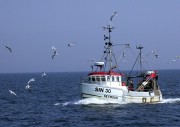 – Det svenska yrkesfisket står inför en dramatisk förändring. Den kommer att bli smärtsamt för många yrkesfiskare, säger Fiskeriverkets generaldirektör Axel Wenblad.
– Det svenska yrkesfisket står inför en dramatisk förändring. Den kommer att bli smärtsamt för många yrkesfiskare, säger Fiskeriverkets generaldirektör Axel Wenblad.
– En drastiskt minskning av fiskeflottan tillsammans med en satsning på skonsamma fångstredskap är nödvändiga åtgärder för att skapa ett lönsamt och såväl miljömässigt som socialt uthålligt fiske.
Den 1 februari införde EU ett system med tilldelning av så kallade kilowattdagar för fiske i Västerhavet. Samtidigt minskades torskkvoten i Kattegatt med omkring 25 procent. I december 2008 enades Sverige och Danmark dessutom om att införa ett fiskefritt område i Kattegatt för att skydda torskbestånden.
Beräkningar som gjorts av Fiskeriverket visar på en överkapacitet på drygt 50 procent inom den svenska torskfiskeflottan i Västerhavet. Den plan som nu antagits ska få fiskeflottan att minska med omkring 40 procent fram till år 2015. Det ska ske genom en ny skrotningskampanj i kombination med en möjlighet att överföra tilldelade kilowattdagar mellan fiskefartyg.
I den havspolitiska propositionen som regeringen lämnade till riksdagen den 17 mars aviserades ytterligare medel för svensk medfinansiering av EU:s fiskerifond, vilket skulle kunna ge utrymme för en ökad skrotning av fiskefartyg. Detta är dock beroende av ett positivt beslut i Övervakningskommittén för strukturprogrammet som leds av jordbruksdepartmentet.
Den 19 mars 2009 överlämnade regeringen även en proposition om att införa överlåtbara fiskerättigheter till riksdagen.
För Stenungsunds stolthet Johnie Berntsson var det tredje gången gillt när han och besättningen som första skandinaver någonsin lyckades vinna det prestigefyllda matchracet Congressional Cup i Long Beach i Californien den 28 mars.
– Det känns väldigt bra att vinna mot så här tufft motstånd, berättar Johnie Berntsson, som är en av få amatörseglare som är med och slåss i seglingens absoluta elitskikt.
Johnie och hans besättning vann 11 av 13 seglingar i ett startfält bestående av bl a dubble OS-guld-medaljören Ben Ainslie, världsrankingledaren Sebastian Col och Americas Cup-skepparen Francesco Bruni. Tuffaste motståndet under inledande seglingarna bjöd dock fransmannen Mathieu Richard.
Finalen gick mot italienaren Francseco Bruni, som länge ledde den första delfinalen. Johnie Bernstson lyckades dock till slut vinna med minsta möjliga marginal och den goda formen höll i sig till den avslutande seglingen som man vann med bred marginal. Utöver prispengarna fick Johnie även motta den åtråvärda röda kavajen, ”the Crimson Blazer”, som tillfallit segraren varje år under de 45 år Congressional Cup har genomförts – denna trofé kommer att finnas att beskåda på Stenungsbaden Yacht Club.
För Johnie Berntsson med Stenungsbaden Yacht Club som en av sina huvudsponsorer, var det här en välkommen seger, efter att ha kommit tvåa i samma tävling två år i rad. Den segrande besättningen bestod av Daniel Wallberg, Johan Barne, Niklas Carlzon, Björn Lundgren och Johan Bäckman.
Johnie, som förra året vann klassiska King Edward VII Gold Cup på Bermuda, har övertygat starkt i den internationella matchracingen på senare tid. Den fortsatta säsongen för teamet handlar mycket om kvalificeringen inför sommarens stora begivenhet på hemmaplan – Match Cup Sweden i Marstrand i månadsskiftet juni-juli, där världseliten samlas för att göra upp. Närmast på programmet står uppvisningsseglingen Spring Regatta 09 under Valborgshelgen hemma på Stenungsbaden Yacht Club.
Länk: www.bsteam.se
Ett av årets intressanta övertaganden inom motorbranschen är den första april 2009 ett faktum. Hansen Racing har förvärvat rätten till Gulf smörjmedel i Sverige. Gulf som varumärke återkom till Sverige i januari 2007 efter många års frånvaro. Nu har dock Gulf hamnat i sin rätta miljö.
 Hansen Racing med ett omfattande återförsäljarnät i hela landet och tusentals motorentusiaster som kunder kommer att satsa på Gulf.
Hansen Racing med ett omfattande återförsäljarnät i hela landet och tusentals motorentusiaster som kunder kommer att satsa på Gulf.
Gulfs välkända logga värmer och berör som en kär gammal vän som kommer tillbaka. Det är något som vi hela tiden får höra när vi presenterar oss säger Martin Steinkamp, f.d. verksamhetsansvarig för Gulf som nu är försäljningsansvarig för Gulfs produktsortiment hos Hansen Racing AB.
Vi ser på detta som ett “Marriage in Heaven” där Hansen Racing, med över 43 års erfarenhet i branschen, och Gulfs starka varumärke med kvalitetsprodukter, kommer att tillföra marknaden ett vinnande koncept, säger Mistral Hansen vd för Hansen Racing.
Gulf grundades 1901 vid den mexikanska Gulfen och har alltid varit ett innovativt bolag genom åren. Den första drive in bensinstationen 1913 och gratis vägkartor samt den första syntetiska motoroljan är några av Gulfs innovationer. Idag sker den tekniska utvecklingen i egen regi samt tillsammans med motortillverkare och olika samarbetspartners, för att få fram de främsta oljorna. Numera är Gulf ett av de stora privatägda oljebolagen med representation i över 90 länder och är ett av världens starkaste varumärken med sin orange disk logga, orörd sen början av 60 talet. Gulf står för service samt innovation med en mycket stark nostalgisk samlareffekt. Tillsammans med Aston Martin Racing är Gulf närvarande i Le Mans långlopp motortävlingar.
Hansen Racing kommer att sälja Gulfs kompletta smörjmedelsprogram inom samtliga marknader –
motor, marin, industri, entreprenad, transport, verkstäder samt skog- och lantbruk. Till detta kommer Gulfs nostalgiska och racinginspirerade klädessortiment även föras.
Målet är att med hög kundservice och täta samarbeten med butiker och återförsäljare ge motorintresserade ett komplett program från Gulf att välja utav, säger Martin Steinkamp avslutningsvis.
Länk: www.gulfoil.se
Länk: www.hansenracing.se
Kraften, känslan och det omisskännliga ljudet hör till det som gör Scanias V8-motor legendarisk. En motor som används i allt från lastbilar till sjöräddningsbåtarna hos SSRS. Lägg till det en utmärkt bränsleförbrukning för klassen, ett rykte att vara nästan oförstörbar och ett utmärkt andrahandsvärde så har man en svårslagen kombination. Det goda ryktet som inleddes med 14-litersmotorn byggs nu på med 16-litersversionen som lanserades år 2000.
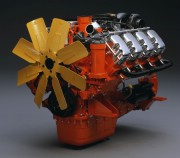 Långsiktig driftekonomi kan tala för en större initialinvestering! Högre prestanda innebär kortare transporttider. Ökad tålighet och driftsäkerhet ger ökad drifttid. Sex års ägande istället för fyra ger lägre värdeminskning, särskilt när andrahandsvärdet ligger på topp.
Långsiktig driftekonomi kan tala för en större initialinvestering! Högre prestanda innebär kortare transporttider. Ökad tålighet och driftsäkerhet ger ökad drifttid. Sex års ägande istället för fyra ger lägre värdeminskning, särskilt när andrahandsvärdet ligger på topp.
Dessa är argument som många av Scanias V8-kunder väger in i kalkylen. Andra tycker helt enkelt att det är svårt att skiljas från sin arbetskamrat. I vissa fall har en renovering av motorn efter så där 200 000 mil varit tillräckligt för att möjliggöra ett andra eller tredje hårt liv… Vad den totala livslängden blir återstår att se då vissa Scania V8-bilar rapporteras fortfarande vara i drift efter över 500 000 mil.
Kungen är född
När Scania presenterade sin 14-liters V8 på 350 hk i slutet av 1960-talet var den Europas starkaste lastbilsmotor, en titel som den försvarade i många år. V8-motorn var det som gav Scania titeln ”King of the Road”.
Utvecklingen påbörjades i en tid då 250 hk ansågs tillräckligt. Ingenjörerna vid Scania-Vabis insåg att sådana effekter inte skulle räcka i längden, särskilt för timmertransporter och tung fjärrtrafik, så varför inte bli först på marknaden med att ta ett banbrytande steg?
Klartecknet år 1962 sammanföll med utvecklingen av en ny generation frambyggda lastbilar som skulle presenteras 1968. En rak åttacylindrig motor skulle inte få plats under en frambyggd hytt, och inte heller en större rak sexa.
Ingenjörerna valde därför en V-motor som kunde få plats under samma hytter som den raka sexan på 11 liter, men ge 100 hk mer. Resultatet var en kraftfull men mycket kompakt kraftkälla som banade väg för lastbilsprestanda på en ny nivå.
”Körbarhet”
Under utvecklingsarbetet med den nya motorns prestanda myntade ingenjörerna begreppet “körbarhet”. Körbarhet betecknar hur en motor, och resten av drivlinan, beter sig vid körning. Maxeffekten är normalt av sekundär betydelse, medan vridmomentet är avgörande för hur väl motorn presterar.
Scania-Vabis ingenjörer definierade god körbarhet som att lastbilen:
• Kräver få växlingar över hela hastighetsregistret.
• Har god dragkraft vid låga motorvarvtal.
• Har tillräckligt kraftöverskott över hela motorvarvtalsregistret.
Scanias nya 14,2-liters V8 hade inga egentliga föregångare bland världens dieselmotorer. Den var konstruerad för turboladdning från början och var dimensionerad för att kunna leverera vad den skulle under ett långt liv. En sugmotorversion på 260 hk fanns även för bussar, en motor som gjorde dåtidens turistbussar till riktiga glidare.
Scanias LB140-modeller blev snart uppskattade. De kombinerade hög effekt med en vridmomentskurva som uppmuntrade till körning på låga motorvarvtal – en bekväm och effektiv kombination i ett tungt fordon. Många kunder gillade också V8-emblemet och det typiska mullrande motorljudet. Detta i kombination med enastående slitstyrka och livslängd gjorde att Scanias 14-liters V8 snabbt blev legendarisk.
Effekt/viktförhållande
Vid mitten av 1970-talet började trafiksäkerhetsmyndigheterna inse att det var nödvändigt att lastbilar hängde med hyfsat i den allmänna trafikrytmen, istället för att orsaka trafikproppar och därmed frustration. Rekommendationen i Tyskland var 8 hk per ton bruttovikt, det vill säga lite drygt 300 hk för maxvikten 38 ton. Scanias V8 på 375 hk gav vid den tidpunkten nära 10 hk/ton, ett förhållande som inte blev vanligt i Europa förrän cirka 25 år senare (40 ton, 400 hk, år 2000).
Samtidigt gav Scanias V8 också tillräcklig prestanda för högre bruttovikter. Idag när 60-tonskombinationer är vanliga i Skandinavien krävs effektnivåer kring 600 hk när man önskar prestanda motsvarande 10 hk/ton.
Framgångar för 14-litersmotorn
14-litersmotorns prestanda höjdes i flera steg upp till 530 hk och 2300 Nm för den sista versionen som tillverkades mellan 1995 och 2001. Effekten hade därmed ökat med mer än 50 procent och vridmomentet med hela 85 procent.
Omkring 170 000 14-liters V8-motorer levererades mellan 1969 och 2001, för användning i lastbilar, industri- och marintillämpningar samt omkring 900 turistbussar.
16-liters efterträdare
V8an på 16 liter lanserades år 2000 och är en helt ny konstruktion baserad på den enhetscylinder som används i alla Scanias nuvarande motorer, 9-, 12-, 13- och 16-liters. 16-litersmotorn har sedan dess gått via Euro 4 till Euro 5. Maxeffekten är idag 620 hk med ett vridmoment på 3000 Nm.
Scania har i många år varit bästsäljande lastbilsmärke i segmentet över 500 hk. Scanias V8-motorer tog Italien med storm på 1970-talet och har sedan dess varit en storsäljare på den marknaden.
V8an är kompakt och har ett fördelaktigt effekt/viktförhållande. Det har gjort den populär i tillämpningar såsom dumpers och andra anläggningsfordon, liksom fordon och båtar för militärt bruk.
Över en kvarts miljon Scania V8-motorer har levererats sedan 1969. Av dessa uppskattas minst hundratusen vara i drift fortfarande.
Länk: www.scania.com/media/v8/
Den politiska majoriteten i Sigtuna koommun vill se ett nytt museum i Sigtuna hamn. Det skriver de i ett pressmeddelande. Här är meddelandet i sin helhet:
Hamnområdet i Sigtuna stad utgör ett av stadens mest centrala och publikt intressanta områden. Fram till idag har området bestått i varvsverksamhet och båtuppläggningsplats.
Småbåtshamnen och Ångbåtsbryggan är stadens entré från sjösidan och en av de mest självklara mötesplatserna i staden. Hamnområdet är dessutom planerat att vara utgångspunkt för den strandpromenad som är under uppbyggnad mot Sjudargårdsbadet i väster och Björkbacka i öster.
Området i hamnen är unikt och skulle kunna utvecklas till att bli mer attraktivt och mer tillgängligt för såväl boende och besökare. Marktillgången är dock begränsad, endast 3000 m2.
Vi i Sigtuna kommuns politiska ledning vill använda hamnområdet på ett bättre sätt än idag. Vi vill öppna upp området och låta allmänheten ha tillträde till denna centrala och trevliga plats. Därför ger vi nu Stadsbyggnadskontoret i uppdrag att ta fram en ny detaljplan för området. Från vår sida är beskedet tydligt: vi vill skapa en mötesplats både för kommuninvånare och besökare i detta område och därför förespråkar vi att ett nytt Sigtuna museum förläggs dit. Vi vill se ett modernt, tekniskt utvecklat, interaktivt och spännande museum som på ett bra sätt presenterar vår fantastiska historia. Arbetet med innehållet i vårt framtida museum drar vi igång nu under våren.
En byggnation av ett nytt museum kan förhoppningsvis påbörjas under nästa mandatperiod.
Sigtuna Båtklubb har idag en del av sin båtuppläggningskapacitet i Sigtuna hamn. Vi vill att kommunen erbjuder möjlighet till utvidgning av båtuppläggningsplatsen i Rävsta så att fortsatt möjlighet finns att förvara sin båt under vinterhalvåret i Sigtunas närhet.
Anders Johansson (S) Bosse Andersson (C) Karolina Windefalk (MP)
En norska finanskändis riskerar en grym båtbot sedan han i juli 2008 stoppats i sin båt utan att ha godkända papper i ordning. Båten är en Fairline Squadron 65, men problemet var att mannen inte hade rätt att köra en så stor båt. Nu riskerar han böter på upp till 42 000 norska kronor (drygt 53 000 svenska kr).
Först erkände finansmannen sin förseelse och fick då ett föreläggande att betala 35 000 kr, men trots att han har en förmögenhet på 180 Mkr vägrade han att betala. Därför har beloppet höjts och är nu alltså uppe i 42 000 kr.
Domen kommer i Aust-Agder tingsrätt 21 april och väckert säkert intresse eftersom mannen sägs vara en världskändis inom shipping och maritim verksamhet.
Länk: www.batmagasinet.no
Kommentarer
Fairline Squadron 68 fiinns för det första inte, det ska vara Fairline Squadron 65. Den väger runt 45 ton inkl bensin + vaten.
Tack för inlägget! Texten är korrigerad.
Ska staten genom Sjöfartsverket ansvara för infrastrukturen i form av utprickade farleder i skärgården eller hur blir det i framtiden? Den frågan vill Göran Andersson (lilla bilden på artikelsidan), ordförande för Svenska Båtunionen, ha klart besked av infrastrukturminster Åsa Torstensson. I ett brev ställt till ministern efterlyser Göran Andersson ett svar innan fredag, då SBU:s årsmöte (Båtriksdagen) hålls.
Här är brevet i sin helhet:
God eftermiddag!
Med anledning av regeringens proposition angående framtida resor och transporter 2008/09:93, så har vi några frågor från Svenska Båtunionen. Vi kanske kan få svar och kommentarer till dessa inför vårt årsmöte, Båtriksdagen 3–4 april.
På sidan 22 står det om turismen
“En näringsgren som är starkt beroende av goda persontransporter…för besökare till turistmål.”
Kan vi tolka detta som att staten genom Sjöfartsverket kommer att ansvara för den infrastruktur i form av utprickade farleder i skärgården som är nödvändig för att både inhemska turister och utländska besökare skall kunna hitta säkert i våra farvatten liksom fritidsbåtar och skärgårdstrafik?
Allltså att Bjelvenstamska utredningsförslaget om att kommuner och intresse organisationer skall ta hand om dessa farleder numera är sänkt på djupt vatten?
Vidare på sidan 48 :
“” Riktade insatser bör också göras…och högre träffsäkerhet åstadkommas. Regeringen överväger vidare att införa ett behörighetsbevis för vissa fritidsfartyg, främst med inriktning på snabba fartyg, samt striktare regler för att stävja sjöonykterhet.””
Innebär detta att ett förslag om obligatoriskt Förarintyg kommer att presenteras inom en snar framtid och att en ny promillegräns för sjöonykterhet införs?
Eftersom information och utbildning har visat sig vara effektivaste sättet att öka förståelsen för sjön och minska antalet tillbud så utgår vi ifrån att regeringen vill satsa på detta tillsammans med bl.a båtorganisationerna.
Med hälsningar
Göran Andersson
ORDFÖRANDE
SVENSKA BÅTUNIONEN
ordforande@batunionen.com
0730-440944
Kommentarer
Vem ska ta ansvaret tycker du?
Smådalarö Gård introducerar en ny aktivitet för sina konferensgäster. Nu finns möjlighet att boka in Anna Drougge som berättar om teamkänsla och kommunikation utifrån sina två jorden-runt-kappseglingar, en föreläsning där deltagarna känslomässigt får sätta sig i samma båt som seglarna.
 – Som föredetting på Volvo-båtarna är detta en självklarhet. Alla har att vinna på en föreläsning om den ultimata tävlingen. Jag hoppas det ger våra gäster ett härlig go i dessa tider, säger Eric Waxin, hotellchef på Smådalarö Gård och seglare.
– Som föredetting på Volvo-båtarna är detta en självklarhet. Alla har att vinna på en föreläsning om den ultimata tävlingen. Jag hoppas det ger våra gäster ett härlig go i dessa tider, säger Eric Waxin, hotellchef på Smådalarö Gård och seglare.
Satsningen på denna nya konferensaktivitet görs för att öka utbudet för gästerna. Det ligger också i tiden då Volvo Ocean Race har sin målgång i Stockholm 16 juni. Dessutom har den stor anknytning till skärgården, havet och Smådalarö Gård.
Föreläsningen med Anna Drougge går att boka från och med 1 april.
Länk: www.smadalarogard.se
I en ny lösning samlar Stena Recycling och Stena Oil in mer farligt avfall med båt från anlöpande fartyg i Göteborgs hamn. Avfallet hanteras sedan på den egna återvinningsanläggningen i Skarvikshamnen. – Ungefär 500 lastbilstransporter tas bort från hamnområdet varje år. Säkerheten ökar och det blir lättare för fartyg att lasta och lossa, säger Jonas Persson, VD Stena Oil.
Anlöpande fartyg till Göteborgs Hamn har skyldighet att lämna ifrån sig farligt eller miljöstörande avfall och varje år lossas cirka 18.000 ton maskinrumsavfall från 12.000 anlöpande fartyg. Det kan exempelvis handla om oljor, övriga kemikalier och förorenat vatten. Med en ny transportlösning för hamnen kan en väsentligt större andel av lastbilstransporterna ersättas med fartyget Tell som endast används för avfallstransporterna.
Miljöfördelarna med båt är betydande. Tell drivs på marin gasoil och kan lasta 150 kubikmeter, jämfört med en lastbil som lastar cirka 12 kubikmeter. Beräkningar visar att den nya hanteringen ersätter cirka 500 lastbilstransporter med farligt avfall från hamn- och cityområdet per år. Lösningen möter också hamnens krav på att få bort så mycket transporter som möjligt inom hamnområdet så att gods kan hanteras så effektivt som möjligt..
– Detta är positivt då det blir möjligt för fartygen att lossa och lasta vid kaj med färre störningar och säkerheten ökar i hamnen, säger Jörgen Wallroth, hamnkapten i Göteborg.
Under de senaste åren har Stena Oil satsat på nya bunkerfartyg med framstående miljö- och säkerhetsprestanda.
– Vi är en bränsleleverantör men denna avfallslösning med en båt endast för avfallstransporter är intressant som sidoverksamhet för att skapa miljöfördelar och möta hamnens krav på ökad effektivitet. Med säkerhetskonceptet Grön bunkring gäller samma stränga regler och rutiner i avfallshanteringen som i leveranserna av fartygsbränslen.
Fartygsavfallet lossas sedan i Skarvikshamnen där det pumpas in i Stena Recyclings behandlingsanläggning.
– Oljehaltigt avfall förädlas där till bland annat nya oljeprodukter som exempelvis kan användas som eldningsolja, säger Johny Aronsson, filialchef på Stena Recycling i Göteborg.
Fiskeriverkets och SCB:s undersökningar visar att årligen deltar 100 000 människor helt ideellt i fiskevårdsarbetet. I Sportfiskeklubbarna sker mycket av detta ideella arbete. Sportfiskarnas fiskevårdsfond stöttar den ideella fiskevården och under Sportfiskemässan i helgen tillkännages årets bidragstagare. Årligen delas ca 200 000 kr ut ur fonden.
Bland de projekt som får bidrag finns många olika typer av projekt riktade mot olika typer av vatten och fiskarter. Till exempel ska Sportfiskarna på Gotland rensa bort så kallade spöknät (förlista fiskenät som fortsätter att fånga och döda fisk och fåglar) vid Digerhuvud på Fårö, ett viktigt område för den hårt trängda östersjötorsken. Fiskeklubben Sydfiskarna i Skurups ska restaurera Vidarbäcken i Skivarpsån genom att återställa bäckens ursprungliga naturtillstånd, ett tidigare mycket värdefullt lekområde för havsöring. Totalt får 9 olika projekt bidrag.
Sportfiskemässan är tillsammans med OKQ8 huvudsponsorer till Fiskevårdsfonden.
– Det är väldigt glädjande att kunna bidra till exempelvis material och maskiner för att bygga vandringsvägar förbi hinder och restaurera skadade livsmiljöer för fiskarter i sjöar, på kusten och i vattendrag, säger Agneta Brunell från Sportfiskemässan.
Från Sportfiskarnas sida menar man att det behövs mer pengar till fiskevården och att de pengar staten skjuter till är otillräckliga. Mer resurser till fiskevård skulle vara positivt både för hotade fiskbestånd och sysselsättningen.
– En effektiv fiskevård är givetvis bra för många hårt trängda fiskbestånd och naturvården men också för Sportfiskebranschens framtid. Det är viktigt att komma ihåg att sportfiske är en av Sveriges bredaste folkrörelser med miljoner utövare. Sportfiskebranschen är också en växande näring som omsätter miljarder samtidigt som fiskbestånden beskattas skonsamt och ekologiskt uthålligt, säger Sportfiskarnas Generalsekreterare Stefan Nyström.
2009 års bidragstagare är:
Linnefors Sportfiskeklubb, Alingsås
Återskapa lekmöjligheterna för öring och andra fiskarter i St Kroksjön och dess biflöden, Alingsås kommun.
Öbacka Sportfiskeklubb, Härnösand
Förbättra miljön för fiskbestånden i klubbens sjöar och sätta fiskevården i fokus för ungdomsverksamheten.
Sportfiskarna, Stockholms skärgård
Skydda och återskapa lekområden för gädda, abborre och öring i Stockholms skärgård, utveckla ett hållbart fiske med kloka fiskeregler samt utbilda och engagera intresserade sportfiskare i fiskevård.
Fiskeklubben Sydfiskarna, Skurups kommun
Restaurera Vidarbäcken i Skivarpsån genom att återställa bäckens ursprungliga naturtillstånd, ett tidigare mycket värdefullt lekområde för havsöring.
Simrishamnsortens Fiskevård och Sportfiskeförening, Simrishamns kommun
Restaurera delar av Tommarpsån med naturliga vattenflöden och livsmiljöer för havsöringbeståndet.
Gotlands Sportfiskeklubb, Gotland
Skydda Gothemsån som ett viktigt lek- och uppväxtområde för gädda, abborre och id samt skapa ett uthålligt fiske.
Sportfiskarna Gotland, Fårö
Ta bort rikliga mängder av så kallade spökgarn utanför Norra Fårö i syfte att hindra att fisk, fåglar och havslevande däggdjur fastnar och dör i förlorade nät som annars fortsätter att fiska år efter år.
Lerumsortens Sportfiske- och Fiskevårdsförening, Lerum
Förbättra miljön för fiskbestånden i klubbens sjöar och sätta fiskevården i fokus för ungdomsverksamheten.
Nordvästra Skånes fiskeallians
Seminarium och utbildning i fiskevård för sportfiskeklubbar och fiskevårdare i Nordvästra Skåne.
Viamare Sea Club kör nu igång ett program med marina utbildningar som hålls på franska rivieran. Deltagarna kan segla och studera intensivt ombord på S/Y Windigo i maj och juni.
Fartygsbefäl VIII
Intensivkurser 5/5 – 12/5 och 26/5 – 2/6 2009 för 6 elever/kurs 18 500 kr inklusive resa, boende ombord med frukost och lunch samt studiematerial.
(medlemmar i Viamare Sea Club betalar endast 16 650 kr inkl. moms).
Tjejkurs för Förarintyg/Båtkörkort
Intensivkurser arrangeras den 2 – 6 juni och den 9 – 13 juni. 9 800 kr inklusive flygresa, boende med frukost och lunch ombord, studiematerial samt examen.
(medlemmar i Viamare Sea Club betalar endast 8 820 kr inkl. moms)
Länk: www.viamareseaclub.com
Precis som förra vintern hotas vikarens ungar av att drunkna och svälta ihjäl i Östersjön. Situationen är långt ifrån lika illa som förra året, men det råder fortfarande isbrist i vissa delar av Östersjön. Enligt Världsnaturfonden WWF befinner sig särskilt sälbestånden i Finlands sydvästra skärgård i fara. Även vikarna i Rigabukten riskerar att drabbas på grund av att det är betydligt mindre is än normalt och för att isen på vissa platser är mycket tunn och lätt går sönder.
Vikarens honor föder sina ungar i slutet av februari och ger di till kutarna i snögrottor på packisen. Om det inte finns någon is, eller om havsisen smälter av för fort, måste sälkutarna vistas i Östersjöns kalla vatten innan de har hunnit bygga upp det nödvändiga och isolerande fettlagret. De dör då ofta av köld och hunger.
– I delar av Östersjön som är viktiga för vikaren finns det inte tillräckligt med is eller ingen is alls. En ny katastrof för sälkutarna är överhängande och många av sälarnas ungar riskerar att dö, varnar Tom Arnbom, sälexpert på Världsnaturfonden WWF. Redan förra vintern förlorade troligen tre av Östersjöns fyra vikarebestånd majoriteten av sina ungar. Det var den mest isfria vintern sedan man började göra mätningar för 300 år sedan. I år är det mer havsis i Östersjön, men det är fortfarande långt under genomsnittsvärdet.
För närvarande beräknas det att det finns runt 10 000 vikare i Östersjön. De är rödlistade av Internationella naturvårdsunionen (IUCN). För den största av de fyra delpopulationerna, den i Bottenviken, är istäcket för närvarande stabilt. Situation för de tre sydliga populationerna är mer problematisk. WWF menar att utsikterna för årets sälkutar att överleva i Ålands skärgård är dålig. Där finns cirka 200 vikare. Kutarna till de drygt 1000 vikarna i Rigabukten är troligen också hotade. Hotbilden för sälkutarna i den tredje populationen i Finska viken är inte lika överhängande, då större delen av viken är för närvarande täckt med is.
– Att sälkutarna dör kan sannolikt kopplas till att effekterna av klimatförändringarna nu också drabbar Östersjön, säger Världsnaturfonden WWFs generalsekreterare Lasse Gustavsson.
Vikarna förökar sig för närvarande endast i områden som i genomsnitt har varit isbelagda i minst 90 dagar per säsong.
– Om de globala koldioxidutsläppen inte minskas radikalt kommer vikarna i själva Östersjön att dö ut, medan de i Bottenviken troligen kommer att klara sig något längre, menar Lasse Gustavsson. Jakt och miljögifter har kraftigt minskat antalet marina däggdjur i Östersjön. Det är först under de senast årtiondena som antalet vikare sakta har börjat återhämta sig. I början av 1900-talet fanns det uppskattningsvis 200 000 vikare i Östersjön.
Nu har även Green Dragon och Telefonica Blue tagit sig i mål i Rio de Janeiro. Därmed är samtliga fem båtar i maratonseglingen från Kina till Brasilien framme vid etappmålet. Efter Ericssonbåtarnas överlägsna dubbelseger var det en ganska avslappnad besättning på Telefonica Blue som kom sist fram till etappmålet.
Telefonica Blue angjorde Rio kl. 03:55 GMT tidigt på söndagsmorgonen (00:55 lokal tid). Vädret var regnigt när båten skar mållinjen vid Marina da Gloria i Rio de Janeiro och därmed säkrade femteplatsen och viktiga poäng i det femte benet av Volvo Ocean Race.
Telefónica Blue seglade tid blev totalt 42 dagar, 22 timmar och 55 minuter. Något längre än de 40 dygn som arrangörerna hade gissat i förväg, alltså.
Men det var inte så här som den holländske skepparen och veteranen Bouwe Bekking och hans team hade tänkt sig avslutningen till Rio. Efter att ha vunnit två delsträckor befordrades Tom Addis från strategist till navigatör ombord. Telefónica Blue hade också fått större roder inför den här delsträckan och besättningen hade hoppats att kunna ta in på försprånget till Ericsson 4.
Men innan racet startade gick båten på grund på en undervattensklippa utanför den kinesiska staden Qingdao. Skeppare Bekking tog snabbt beslutet att inte starta utan återgå till den olympiska hamnen med Telefónica Blue där båten lyftes och skadorna inspekterades.
Det var dock inga strukturella skador på båten och de återupptog tävlingen efter endast 19 timmar. Därmed var Telefónica Blue åter på banan.
De kämpade hårt för att ta sig tillbaka in i tävlingen, men efter 20 dygn brast förstaget och endast besättningens skicklighet hndrade riggen från att falla ner.
Bekking är fortfarande optimistisk inför resten av tävlingen. Många poäng står fortfarande på spel och de båtar som inte var med på leg fem kommer att finnas med på startlinjen när båtarna lämnar Rio.
Leg Five Finishing Order – Rio de Janeiro
1. Ericsson 3: 8 points
2. Ericsson 4: 7 points
3. PUMA: 6 points
4. Green Dragon: 5 points
5. Telefonica Blue: 4 points
Overall Leaderboard (Provisional)
1. Ericsson 4 (Torben Grael/BRA) 63.5 points (FINISHED)
2. PUMA (Ken Read/USA) 53 points (FINISHED)
3. Telefónica Blue (Bouwe Bekking/NED) 50.5 points (FINISHED)
4. Ericsson 3 (Magnus Olsson/SWE) 43.5 (FINISHED)
5. Green Dragon (Ian Walker/GBR) 39.5 (FINISHED)
6. Telefónica Black 21 (DNS)
7. Delta Lloyd 12 (DNS)
8. Team Russia 10.5 (DNS)
Sjöklädestillverkaren Henri Lloyd går inn i ett samarbete med Formel 1-teamet Brawn GP inför 2009 års Formel 1 säsong. Henri Lloyd blir officiell leverantör av Clothing och Footwear Technology. Henri Lloyd är ett av de marknadsledande varumärkena inom teknisk segling och lifestylekonfektion, och har i över 45 år gått i täten för utvecklingen av material, design och produktutveckling.
Pressrelease:
Henri Lloyds kunskap och erfarenhet av innovativ materialteknologi har applicerats i de kläder som Brawn GPs team kommer att bära under Formel 1 säsongen 2009, för att skapa en uniform som är anpassad till de olika klimatmiljöer som teamet kommer att stöta på under de 17 olika racen i Grand Prix kalendern.
– Vi är mycket glada över att välkomna Henri Lloyd till Brawn GPs team. Vi är stolta över att starta upp ett samarbete med ett företag och ett varumärke som själva tar stolthet i sin innovation och design, och vi kommer att arbeta mycket hårt med Henri Lloyd för att skapa kläder som ger högsta möjliga nivå inom textilteknoligi för vår mycket krävande arbetsmiljö, säger Ross Brawn, chef för Brawn GP.
– Teamet har tävlat mot klockan för att färdigställa våra förberedelser för säsongens första race i Melbourne och vi vill tacka Henri Lloyd som har delat vår vision om teamets framtid och dess satsning.
– Vi tycker att det är mycket spännande att gå in i ett officiellt samarbete med Brawn GP, ett team som reflekterar vårt Brittiska arv och som också speglar produktinnovation och teknologi. Vi är exalterade över vår framtid ihop och önskar teamet all framgång 2009 års Formel 1 säsong, säger Paul Strzelecki, Henri Lloyds VD.
Henri Lloyd grundades 1963 I Manchester, England, och började som en tillverkare av seglings och outdoorkläder och blev snabbt ledande inom tekniska sjökläder. 1984 klev Henri Lloyd på allvar in på fashionmarknaden, efter att Henri Lloyds originalseglarjacka, The Consort Jacket togs upp av The Milan Scooter Society, Panninari, som deras inofficiella ”uniform”.
Henri Lloyd säljs och marknadsförs i Sverige av Sportmanship AB.
Länk: www.henrilloyd.com
Nu har även Ericsson 4 och Puma gått i mål i Rio de Janeiro. Ericsson 4 blev tvåa efter systerbåten Ericsson 3 i världens hittills längsta etapp av Volvo Ocean Race. Ericsson Racing Teams andra båt skar mållinjen kl. 2257 GMT (19.57 lokal tid) i skepparen Torben Graels hemmahamn.
Ericsson 4 drygar därmed ut sin totala poängsumma till 63.5 poäng och leder därmed med 10.5 poäng före PUMA (Ken Read/USA) som, tagit tillbaka den sammanlagda andraplatsen i tävlingen. Vid tiden för Ericsson 4:s målgång hade Puma fortfarande 49.4 Nm kvar att segla till målet.
Det här är den tredje delsegern för Torben Grael och besättningen ombord på Ericsson 4. De vann även etapp 1 och 2 och fick maximala poäng för in-port race i både Singapore och Qingdao.
Efter att ha varit till sjöss i 40 dagar, 17 timmar, 57 minuter och 44 sekunder togs Grael & Co. emot av den brasilianska staden med karnevalsyra och applåder. Den brasilianska skepparen kunde inte dölja att han fyllts av hemlängtan:
– Vi har drömt om det här en hel vecka och det känns fantastiskt skönt att vara hemma igen. Mottagandet har varit väldigt fint.
Ericsson 4 låg i ledningen när båtarna i Volvo Ocean Race tvingades ta beslut hur de skulle tackla vindarna vid Fiji på dag 16, 1 mars. Skeppare Torben Grael valde det ostliga alternativet tillsammans med Ericsson 3 och Green Dragon och ledde därefter fältet över den första scoring gaten och fick därmed fyra poäng. Ericsson 3 tog sedan det modiga beslutet att gå mer norrut än de övriga båtarna medan Ericsson 4 lämnades kvar för att slåss om andraplatsen tillsammans med PUMA (Ken Read/USA).
Efter Ericsson 4:s målgång kom även Puma in till Rio. Här är deras senaste pressinformation och den senaste poängtabellen:
PUMA TAKES THIRD PODIUM POSITION
Ken Read/USA guided PUMA over the finish line this morning in Rio de Janeiro at 0427 GMT (0127 local) to claim the third podium place on leg five of the Volvo Ocean Race, a result good enough for Read to retain second position in the race overall at this halfway stage.
Ken Read and his team now have 53 points on the scoreboard having added six leg points and six gate points to their tally. This keeps them in second place, but only a whisker ahead Telefónica Blue, whose total will be 50.5 points at the end of this leg, assuming they hold their current position. Even if Telefónica Blue should beat Green Dragon on this leg, which now seems unlikely, it will not affect PUMA’s overall second place standing in the race.
Read is skippering an entry in the event for the first time, and on this leg he had his first taste of the Southern Ocean and the experience of rounding Cape Horn. On reaching the dock in the Marina da Gloria, Read said: “It was a really long race. I wondered if we would end up having to try and pace ourselves, but the fact is, there’s no such thing. If you try to pace yourself, you just lose, so you can’t.” The team recorded an elapsed time of 40 days 23 hours 26 minutes 60 seconds.
On the approach to the finish, Read wrote, “We will have this experience to look back on forever, although I don’t think the magnitude of this leg will really sink in until after the completion of the race. Where we have been, what we have seen, the laughs, the frustration, the hardships are the moments in time that one can never forget – none of it can be taken away.”
Throughout the leg, PUMA was consistently in the top three, only dropping to fourth momentarily and on three occasions leading the fleet. From day 24, 9 March, they settled into third place and held that right through to the finish today.
Leg Five Finishing Order Rio
1. Ericsson 3: 8 points
2. Ericsson 4: 7 points
3. PUMA: 6 points
Overall Leaderboard (Provisional)
1. Ericsson 4 (Torben Grael/BRA) 63.5 points (FINISHED)
2. PUMA (Ken Read/USA) 53 points (FINISHED)
3. Telefónica Blue (Bouwe Bekking/NED) 46.5 points (RACING)
4. Ericsson 3 (Magnus Olsson/SWE) 43.5 (FINISHED)
5. Green Dragon (Ian Walker/GBR) 34.5 (RACING)
6. Telefónica Black 21 (DNS)
7. Delta Lloyd 12 (DNS)
8. Team Russia 10.5 (DNS)

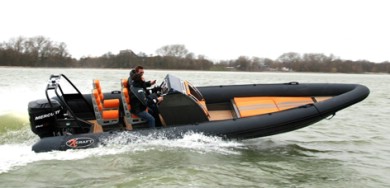



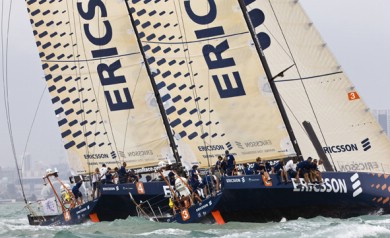
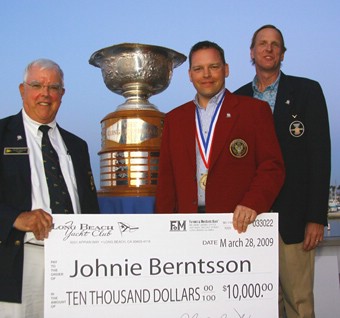




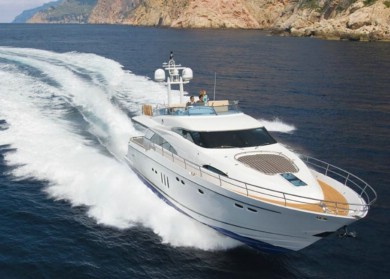
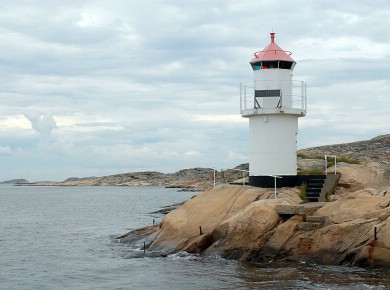








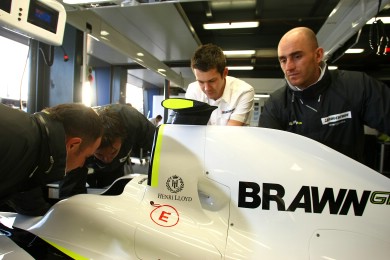
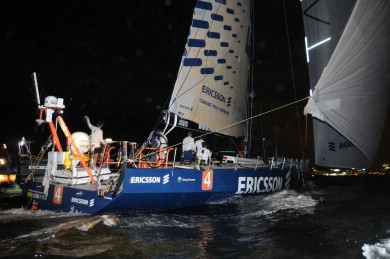





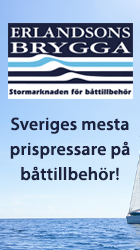
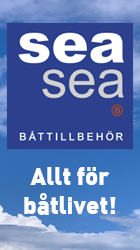
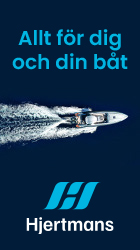

Kommentarer
Grattis Johnny!